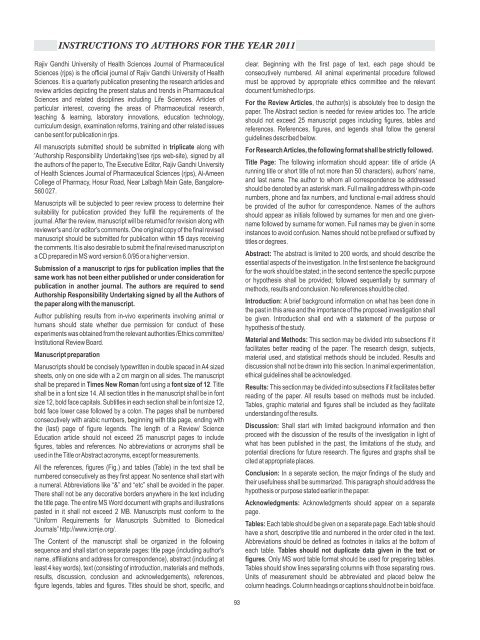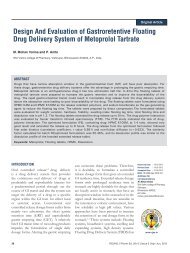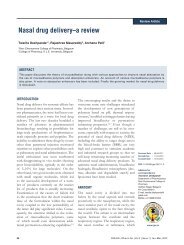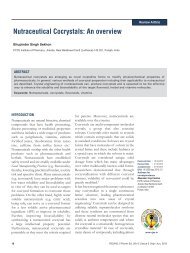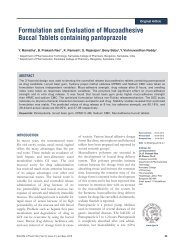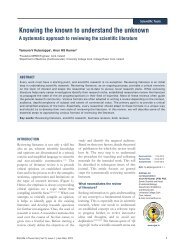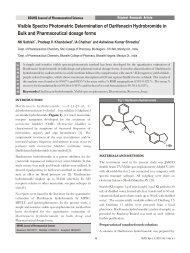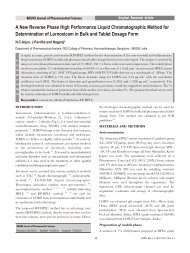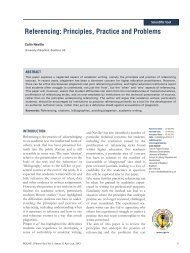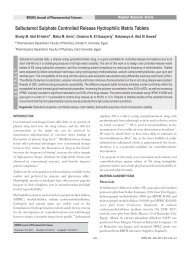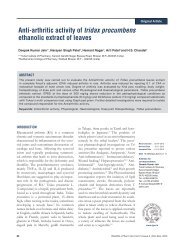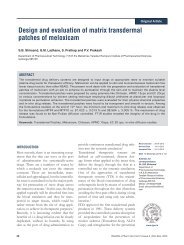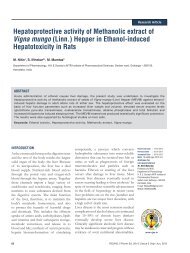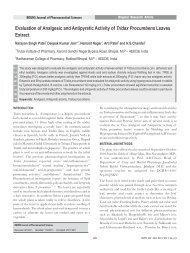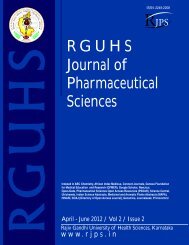final .cdr
final .cdr
final .cdr
You also want an ePaper? Increase the reach of your titles
YUMPU automatically turns print PDFs into web optimized ePapers that Google loves.
INSTRUCTIONS TO AUTHORS FOR THE YEAR 2011<br />
Rajiv Gandhi University of Health Sciences Journal of Pharmaceutical<br />
Sciences (rjps) is the official journal of Rajiv Gandhi University of Health<br />
Sciences. It is a quarterly publication presenting the research articles and<br />
review articles depicting the present status and trends in Pharmaceutical<br />
Sciences and related disciplines including Life Sciences. Articles of<br />
particular interest, covering the areas of Pharmaceutical research,<br />
teaching & learning, laboratory innovations, education technology,<br />
curriculum design, examination reforms, training and other related issues<br />
can be sent for publication in rjps.<br />
All manuscripts submitted should be submitted in triplicate along with<br />
'Authorship Responsibility Undertaking'(see rjps web-site), signed by all<br />
the authors of the paper to, The Executive Editor, Rajiv Gandhi University<br />
of Health Sciences Journal of Pharmaceutical Sciences (rjps), Al-Ameen<br />
College of Pharmacy, Hosur Road, Near Lalbagh Main Gate, Bangalore-<br />
560 027.<br />
Manuscripts will be subjected to peer review process to determine their<br />
suitability for publication provided they fulfill the requirements of the<br />
journal. After the review, manuscript will be returned for revision along with<br />
reviewer's and /or editor's comments. One original copy of the <strong>final</strong> revised<br />
manuscript should be submitted for publication within 15 days receiving<br />
the comments. It is also desirable to submit the <strong>final</strong> revised manuscript on<br />
a CD prepared in MS word version 6.0/95 or a higher version.<br />
Submission of a manuscript to rjps for publication implies that the<br />
same work has not been either published or under consideration for<br />
publication in another journal. The authors are required to send<br />
Authorship Responsibility Undertaking signed by all the Authors of<br />
the paper along with the manuscript.<br />
Author publishing results from in-vivo experiments involving animal or<br />
humans should state whether due permission for conduct of these<br />
experiments was obtained from the relevant authorities /Ethics committee/<br />
Institutional Review Board.<br />
Manuscript preparation<br />
Manuscripts should be concisely typewritten in double spaced in A4 sized<br />
sheets, only on one side with a 2 cm margin on all sides. The manuscript<br />
shall be prepared in Times New Roman font using a font size of 12. Title<br />
shall be in a font size 14. All section titles in the manuscript shall be in font<br />
size 12, bold face capitals. Subtitles in each section shall be in font size 12,<br />
bold face lower case followed by a colon. The pages shall be numbered<br />
consecutively with arabic numbers, beginning with title page, ending with<br />
the (last) page of figure legends. The length of a Review/ Science<br />
Education article should not exceed 25 manuscript pages to include<br />
figures, tables and references. No abbreviations or acronyms shall be<br />
used in the Title or Abstract acronyms, except for measurements.<br />
All the references, figures (Fig.) and tables (Table) in the text shall be<br />
numbered consecutively as they first appear. No sentence shall start with<br />
a numeral. Abbreviations like “&” and “etc” shall be avoided in the paper.<br />
There shall not be any decorative borders anywhere in the text including<br />
the title page. The entire MS Word document with graphs and illustrations<br />
pasted in it shall not exceed 2 MB. Manuscripts must conform to the<br />
“Uniform Requirements for Manuscripts Submitted to Biomedical<br />
Journals” http://www.icmje.org/.<br />
The Content of the manuscript shall be organized in the following<br />
sequence and shall start on separate pages: title page (including author's<br />
name, affiliations and address for correspondence), abstract (including at<br />
least 4 key words), text (consisting of introduction, materials and methods,<br />
results, discussion, conclusion and acknowledgements), references,<br />
figure legends, tables and figures. Titles should be short, specific, and<br />
93<br />
clear. Beginning with the first page of text, each page should be<br />
consecutively numbered. All animal experimental procedure followed<br />
must be approved by appropriate ethics committee and the relevant<br />
document furnished to rjps.<br />
For the Review Articles, the author(s) is absolutely free to design the<br />
paper. The Abstract section is needed for review articles too. The article<br />
should not exceed 25 manuscript pages including figures, tables and<br />
references. References, figures, and legends shall follow the general<br />
guidelines described below.<br />
For Research Articles, the following format shall be strictly followed.<br />
Title Page: The following information should appear: title of article (A<br />
running title or short title of not more than 50 characters), authors' name,<br />
and last name. The author to whom all correspondence be addressed<br />
should be denoted by an asterisk mark. Full mailing address with pin-code<br />
numbers, phone and fax numbers, and functional e-mail address should<br />
be provided of the author for correspondence. Names of the authors<br />
should appear as initials followed by surnames for men and one givenname<br />
followed by surname for women. Full names may be given in some<br />
instances to avoid confusion. Names should not be prefixed or suffixed by<br />
titles or degrees.<br />
Abstract: The abstract is limited to 200 words, and should describe the<br />
essential aspects of the investigation. In the first sentence the background<br />
for the work should be stated; in the second sentence the specific purpose<br />
or hypothesis shall be provided; followed sequentially by summary of<br />
methods, results and conclusion. No references should be cited.<br />
Introduction: A brief background information on what has been done in<br />
the past in this area and the importance of the proposed investigation shall<br />
be given. Introduction shall end with a statement of the purpose or<br />
hypothesis of the study.<br />
Material and Methods: This section may be divided into subsections if it<br />
facilitates better reading of the paper. The research design, subjects,<br />
material used, and statistical methods should be included. Results and<br />
discussion shall not be drawn into this section. In animal experimentation,<br />
ethical guidelines shall be acknowledged.<br />
Results: This section may be divided into subsections if it facilitates better<br />
reading of the paper. All results based on methods must be included.<br />
Tables, graphic material and figures shall be included as they facilitate<br />
understanding of the results.<br />
Discussion: Shall start with limited background information and then<br />
proceed with the discussion of the results of the investigation in light of<br />
what has been published in the past, the limitations of the study, and<br />
potential directions for future research. The figures and graphs shall be<br />
cited at appropriate places.<br />
Conclusion: In a separate section, the major findings of the study and<br />
their usefulness shall be summarized. This paragraph should address the<br />
hypothesis or purpose stated earlier in the paper.<br />
Acknowledgments: Acknowledgments should appear on a separate<br />
page.<br />
Tables: Each table should be given on a separate page. Each table should<br />
have a short, descriptive title and numbered in the order cited in the text.<br />
Abbreviations should be defined as footnotes in italics at the bottom of<br />
each table. Tables should not duplicate data given in the text or<br />
figures. Only MS word table format should be used for preparing tables.<br />
Tables should show lines separating columns with those separating rows.<br />
Units of measurement should be abbreviated and placed below the<br />
column headings. Column headings or captions should not be in bold face.


